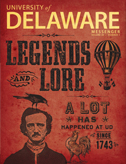Can you be a brain without the pain?

CAMPUS | An education is a satisfying thing to have. Getting that education is not always so joyful.
School is hard. It’s time-consuming, frequently agonizing and sometimes regarded by students more as a pain than a pleasure. So why not take a shortcut? Why not grab the CliffsNotes version, or sign up for that mail-order drawing course? Are streamlined paths to knowledge effective, or at least potentially beneficial, or are we only cheating ourselves when we try an end-around on the academic system?
UD School of Education Prof. Robert Hampel knows a lot about such things. He spent the past 15 years researching and writing his new book, Fast and Curious: A History of Shortcuts in American Education (Rowman and Littlefield, 2017).
In it, Hampel examines such classic examples of mass-market education as Norman Rockwell’s art correspondence school (ca. 1948-81), Evelyn Wood’s speed reading classes (1959-present), and even the night law schools held at YMCAs in the early 20th century.
Some educational shortcuts—the “faster-but-harder” techniques such as the accelerated coursework of UD’s Winter Session—clearly work when students embrace academic rigor and cut back on extracurricular activities. Others—especially “faster-and-easier” methods touted in countless sales pitches since the late 19th century—are more likely to lighten bank accounts than enlighten the mind.
“The ads played on your fear you were being left behind, either in your career or your culture,” says Hampel, who notes that tighter government regulation has reduced their prevalence. “What I criticize them for is the way they raised hopes and dreams—the hype. Beware of anyone who tells you an education is effortless.”
Yet these shortcuts endure—partly because of our desire to be perceived as cultured, and partly due to culture itself. “Psychologist Jean Piaget said there is a side of this that is distinctly American,” he says. “Most Americans want things fast.”



